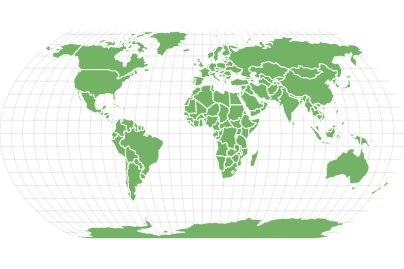Blue Whale
Balaenoptera musculus
The largest animal on Earth!
Advertisement
Blue Whale Scientific Classification
- Kingdom
- Animalia
- Phylum
- Chordata
- Class
- Mammalia
- Order
- Cetacea
- Family
- Balaenopteridae
- Genus
- Balaenoptera
- Scientific Name
- Balaenoptera musculus
Read our Complete Guide to Classification of Animals.
Blue Whale Conservation Status
Blue Whale Facts
- Prey
- Krill, Crustaceans, Small Fish
- Name Of Young
- Calf
- Group Behavior
- Solitary
- Fun Fact
- The largest animal on Earth!
- Estimated Population Size
- Less than 20,000
- Biggest Threat
- Climate change
- Most Distinctive Feature
- Pleats on neck and two blow-holes
- Other Name(s)
- Northern, Southern, Pygmy
- Gestation Period
- 11 -12 months
- Habitat
- All oceans, except the Arctic
- Predators
- Humans, Killer Whale pods
- Diet
- Carnivore
- Average Litter Size
- 1
- Lifestyle
- Diurnal
- Common Name
- Blue Whale
- Number Of Species
- 3
- Location
- Oceans worldwide
- Slogan
- The largest animal on Earth
- Group
- Mammal
Blue Whale Physical Characteristics
- Color
- Grey
- Blue
- Black
- White
- Skin Type
- Smooth
- Top Speed
- 13 mph
- Lifespan
- 80-90 years
- Weight
- 220,000 lbs - 352,000 lbs
- Length
- 25m - 30m (82.5ft - 100ft)
- Age of Sexual Maturity
- 10- 15 years
- Age of Weaning
- 8 months
View all of the Blue Whale images!
Classification
The blue whale is a type of baleen whale that, depending on the time of year, is found in oceans all across the globe. Its scientific name is Balaenoptera musculus. Balaenoptera translates to “winged whale”, while musculus translates to “muscle” (although it could actually be “mouse”, which would have been a bit of a joke from the person who originally named the blue whale.
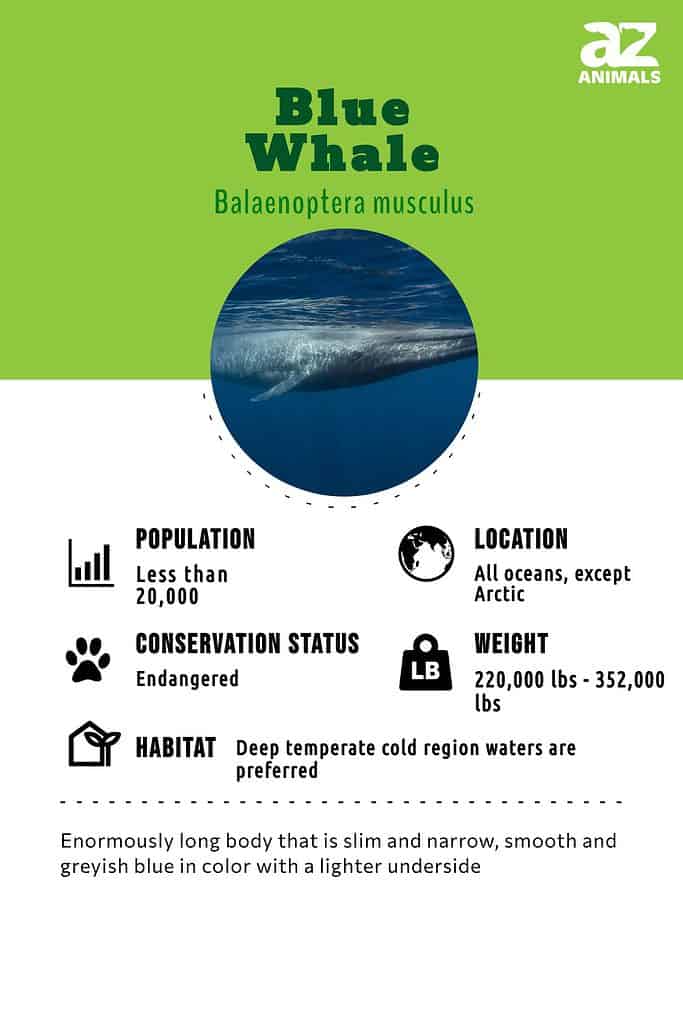
Anatomy and Appearance
This great mammoth has an extremely long, narrow body which means that allows them to swim more easily. Without a doubt, this species of whale is the biggest whale living today. Their skin is smooth and greyish-blue in color with a lighter underside. They have a series of pleats on their throats which allows them to expand to more than four times their normal size feeding. The tail of the blue whale splits into rubbery flukes which help to improve swim speed and efficiency.
Like other baleen whales, blue whales have almost 400 baleen plates instead of teeth. These are hard and bristly to function as filters for blue whales to feed by taking in great amounts of water.
Blue whales have two blowholes that expel water from their lungs. They do this from the top of their heads when they come to the surface every so often to breathe.
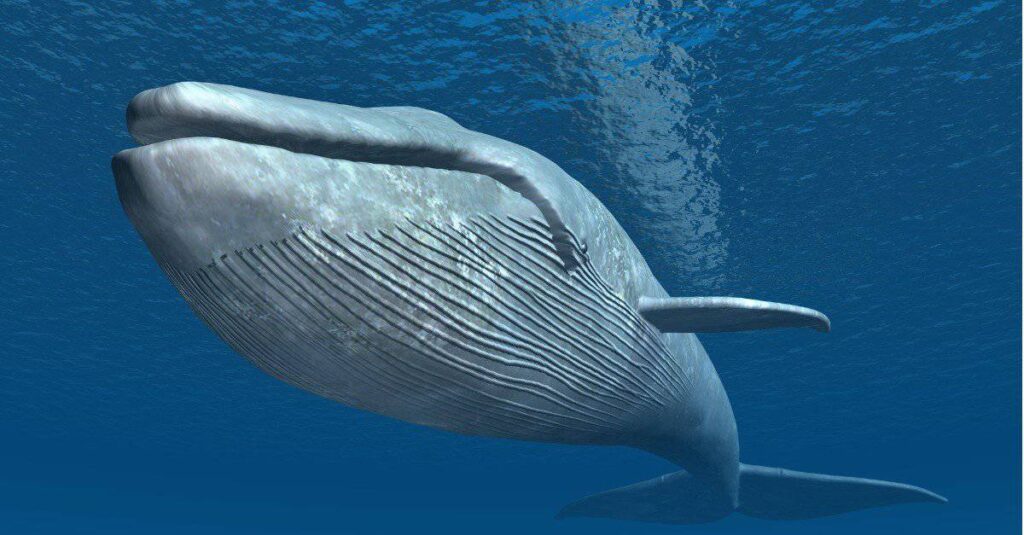
The Blue Whale has an enormously long body that is slim and narrow, which means that they are able to cut through the water with ease.
©iStock.com/MR1805
4 Types of Blue Whales
There are four recognized subspecies of the Blue Whale and potentially a fifth subspecies off the coast of Chile.
- North Atlantic & North Pacific Blue Whale – North Atlantic & North Pacific Blue Whales can be found in a few regions including New England to Greenland, the U.S. West coast, and from Alaska to Hawaii to the Kamchatka Penisula.
- Southern Ocean (Antarctic) Blue Whale – Southern Ocean (Antarctic) Blue Whales are found all around Antarctica, but they do venture pretty far north searching for food through several different oceans.
- Indian Ocean & South Pacific (Pygmy) Blue Whale – Indian Ocean & South Pacific (Pygmy) Blue Whales despite their name, still reach an average length of 78 feet.
- Northern Indian Ocean Blue Whale – Northern Indian Ocean Blue Whales are almost always found in the Northern Indian Ocean with little variation.
Evolution and History
Blue whales are found throughout the world’s oceans, except for the Arctic. Growing to around 100 feet long, it is thought that it could be the biggest creature that has ever existed. It is definitely the largest alive today. Learn about the largest ocean animals to have ever lived here.
The blue whale diverged from other Balaenopteridae (including fin whales and northern minke whales) between 5 and 10 million years ago, and the oldest fossil representing something similar to today’s blue whale dates back almost 2 million years ago.
Although their enormous size and slow-maturing nature have meant that the world’s Blue Whale population has never been greatly numerous, they have drastically declined in numbers due to having been hunted by humans, particularly over the past one hundred years.
Blue Whales are now legally protected from commercial whaling.
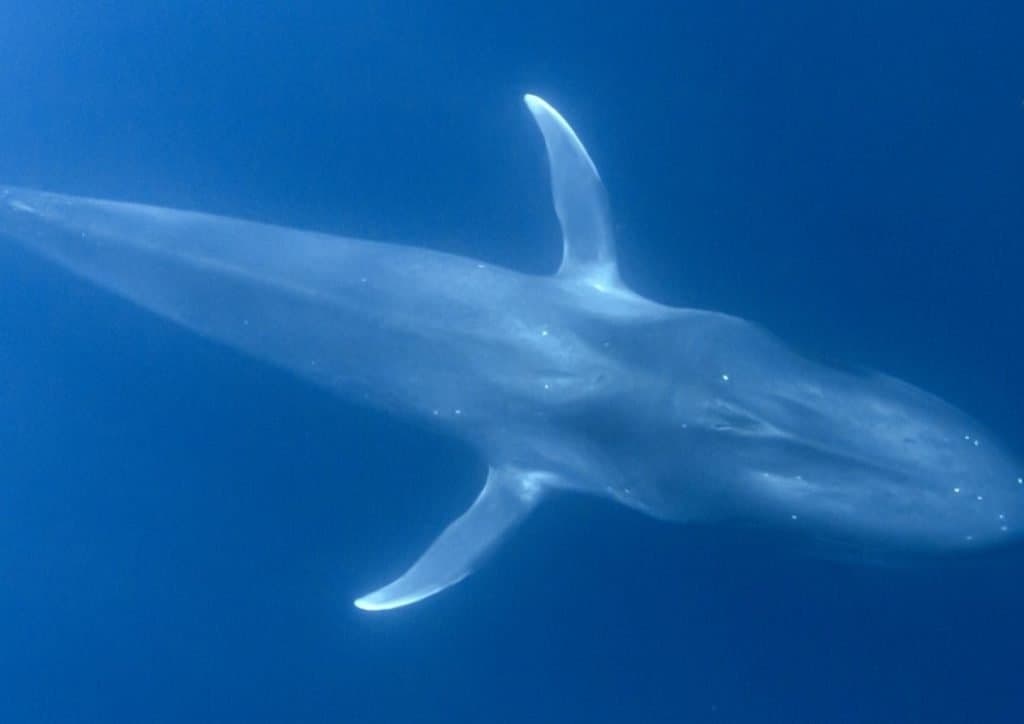
The blue whale might be the biggest creature that has ever existed.
©Rich Carey/Shutterstock.com
Distribution and Habitat
Found in oceans mostly worldwide, blue whales migrate at different times of the year. In the summer months, Blue Whales are found in the cold waters where they feed on plentiful food, before moving towards warmer waters to breed. The migratory patterns of blue whales are generally less well understood and seem more unpredictable than other baleen whales, even skipping migration some years.

Behavior and Lifestyle
Unlike some other whales, blue whales are primarily solitary animals. They do sometimes gather to feed in groups and when they are breeding or mothers are with young.
Blue whales are known for their use of a variety of sounds (known as songs) including hums, squeaks, and rumble to communicate with one another, particularly during the breeding season in winter. Maybe not too surprisingly, these gigantic mammals make some enormous noises! In fact, reaching volumes of over 180 decibels they make the loudest sound of any other animal.
The Blue Whale has very small fins and flippers so rely on its enormous tail to help it to plow through the ocean. Blue Whales also use their tails to make deep dives as by bringing it above the surface of the water, they are able to get enough power to travel up to 200 meters steeply down into the sea.
Reproduction and Life Cycles
Blue Whales breed in the warmer, tropical waters during the winter or early spring when after a gestation period that lasts for nearly a year, the female Blue Whale gives birth to a single calf on her return to the region the following year. After spending all summer feeding in the cold, rich waters at the poles, female Blue Whales eat almost nothing whilst they are nursing their young. Newborn Blue Whales already measure seven meters in length and weigh around 2.5 tonnes and remain by their mother’s side for at least their first year. Before they are weaned by the time they are eight months old, Blue Whale calves are known to consume up to 90kg of milk every day. Blue Whales are able to start reproducing themselves when they are between 10 and 15 years old with females giving birth every two or three years. Blue whales can live for up to 40 years.
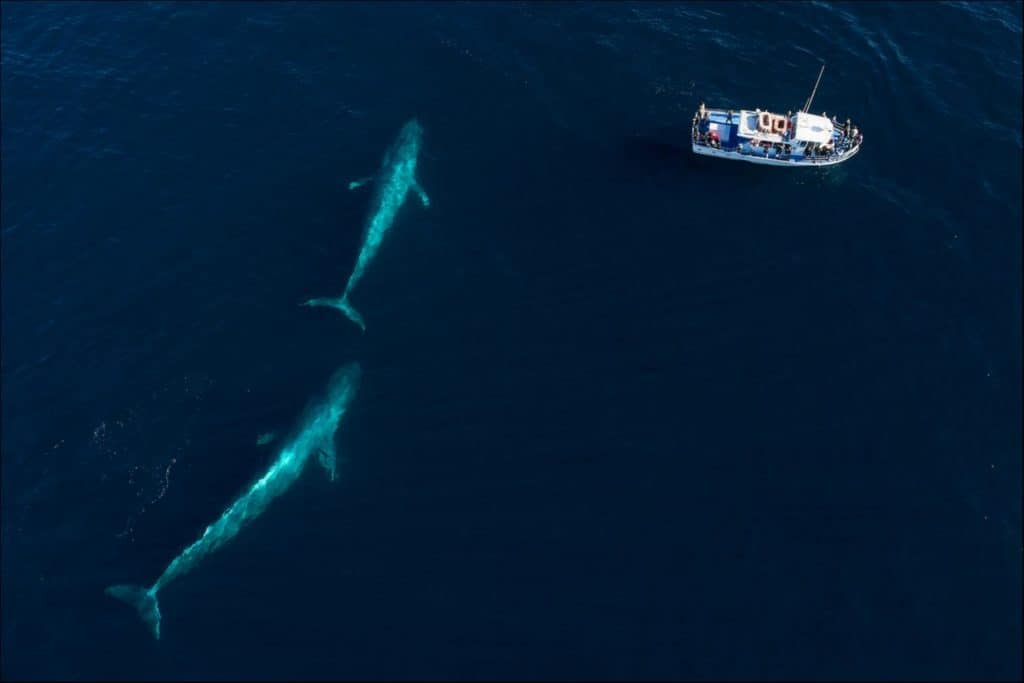
Blue Whales are able to start reproducing themselves when they are between 10 and 15 years old with females giving birth every two or three years.
©Chase Dekker/Shutterstock.com
Diet and Prey
The Blue Whale is a carnivorous animal that despite the fact that it doesn’t have proper teeth, survives on a diet that is mainly comprised of krill and small crustaceans, along with the occasional small fish. Blue Whales feed by swimming up towards a shoal of prey and thanks to the pleats on their neck which allows their throat to expand, take an enormous gulp of water into the sac created in their lower jaw and shut their mouths. The water is then expelled but thousands of tiny creatures are retained by their fine baleen plates which are then swallowed. Blue Whales are able to consume up to six tonnes of prey every day during the summer months which they spend in the cold, rich waters around the poles. Although Blue Whales are known to eat a tremendous amount during the summer, when they migrate to the warmer waters for winter to breed they will barely eat anything at all. For a complete analysis of their diet, give our ‘What Do Blue Whales Eat?’ page a read!”
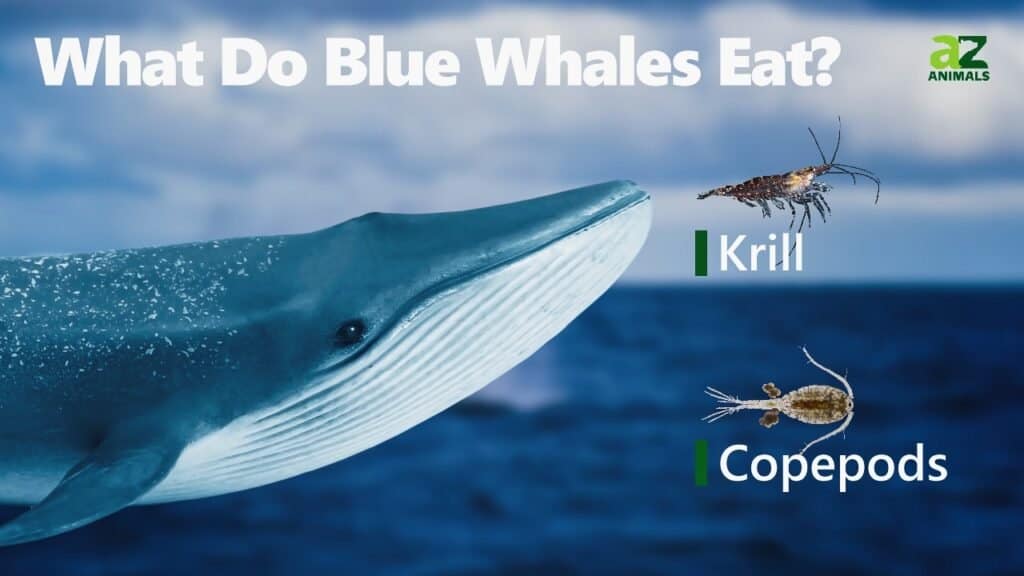
Predators and Threats
It’s probably no surprise that blue whales have no predators in the ocean, because what could eat them? They sit at the very top of the size category for animals. Their young, however, are at risk from attacks by killer whales which are able to hunt them down with cunning and intelligence.
Sadly, once whalers and hunting technology produced more advanced harpoons in the 19th century, mankind increased commercial hunting of the huge beasts. Throughout the first half of the 20th century, the blue whale population was crushed due to overhunting for their valuable blubber and meat. Since the 1960’s there has been a global ban on commercial whaling on the blue whale.
Blue Whale Interesting Facts and Features
Here are some great blue whale facts!
- The largest blue whale ever recorded was captured in 1947 and weighed 418,878 pounds.
- Blue Whales must come to the surface to breathe in air, which happens every 8-12 minutes.
- 9 meters is how high blue whales can push water, air, and mucus out of their blowholes.
- The brain of a Blue Whale weighs as much as 15 lbs.
- The lungs are so large that one full breath from a blue whale could fill 2,000 ballons.
- The heart of the Blue Whale is so big that it is around the same size as a small car.
- The arteries of the heart are wide enough for someone to swim through.
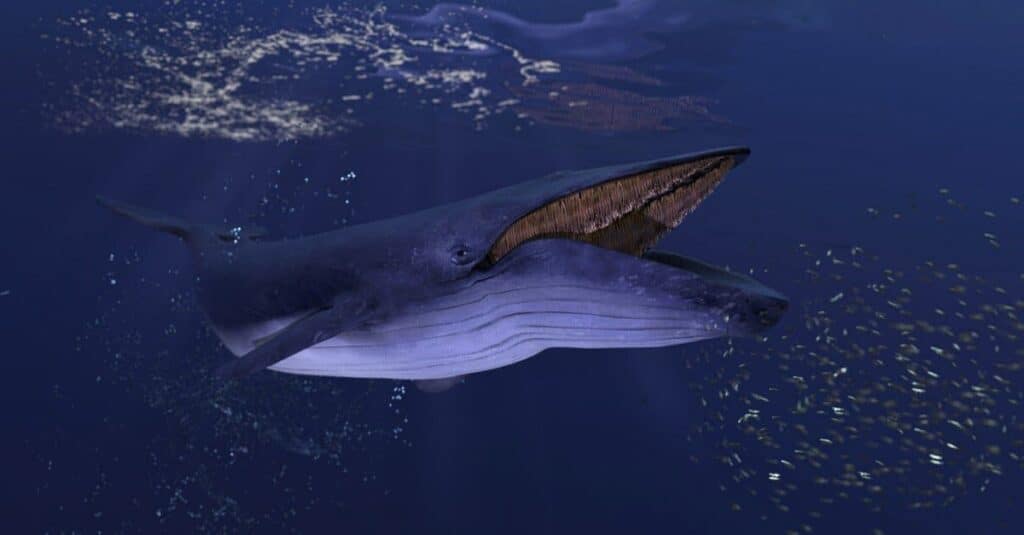
Blue Whales feed by swimming up toward prey and expanding their throat to take an enormous gulp of water into the sac created in their lower jaw and shut their mouths.
©bekirevren/Shutterstock.com
Conservation and Human Relationship
The blue whale’s relationship with humans has changed drastically over the past 80 or so years. Before the 1960s, blue whales were commercially hunted into scarcity for products refined from their meat and blubber. In fact, 1978 was the last year that a blue whale was intentionally hunted.
Many years ago, man would only be able to obtain blue whale meat and blubber when there was a beaching or some other event that washed one ashore. As whaling technology improved, hunters were able to really pursue blue whales in the open oceans.
Because of the overhunting, the blue whale population has dropped from what biologists estimate 200,000 in the 1800s to 20,000 today. They are listed by the IUCN as an animal that is Endangered. Their greatest threat today is global warming.
Now, blue whales are part of sightseeing tours and are highly protected. These huge, unique whales are coveted today for the wonders they are.

Blue Whale FAQs (Frequently Asked Questions)
Are Blue Whales herbivores, carnivores, or omnivores?
Blue Whales are Carnivores, meaning they eat other animals.
What Kingdom do Blue Whales belong to?
Blue Whales belong to the Kingdom Animalia.
What phylum do Blue Whales belong to?
Blue Whales belong to the phylum Chordata.
What class do Blue Whales belong to?
Blue Whales belong to the class Mammalia.
What family do Blue Whales belong to?
Blue Whales belong to the family Balaenopteridae.
What order do Blue Whales belong to?
Blue Whales belong to the order Cetacea.
What genus do Blue Whales belong to?
Blue Whales belong to the genus Balaenoptera.
What type of covering do Blue Whales have?
Blue Whales are covered in Smooth skin.
Where do Blue Whales live?
Blue Whales live in oceans worldwide.
In what type of habitat do Blue Whales live?
Blue Whales live in polar and subtropical waters.
What are some predators of Blue Whales?
Predators of Blue Whales include humans and killer whale pods.
What is the average litter size for a Blue Whale?
The average litter size for a Blue Whale is 1.
What is an interesting fact about Blue Whales?
Blue Whales are the largest animal on Earth.
What is the scientific name for the Blue Whale?
The scientific name for the Blue Whale is Balsenoptera musculus.
What is the lifespan of a Blue Whale?
Blue Whales can live up to 90 years.
What is a baby Blue Whale called?
A baby Blue Whale is called a calf.
How many species of Blue Whale are there?
There are 3 species of Blue Whale.
What is the biggest threat to the Blue Whale?
The biggest threat to the Blue Whale is climate change.
How many Blue Whales are left in the world?
There are less than 20,000 Blue Whales left in the world.
How fast is a Blue Whale?
A Blue Whale can travel at speeds of up to 13 miles per hour.
Do whales poop?
Yes, whales poop.
What's the difference between blue whales and sperm whales?
Blue whales grow far larger than sperm whales. In addition, sperm whales feed using their teeth, while blue whales feed using a baleen.
What's the difference between blue whales and humpback whales?
Blue whales grow far larger than humpback whales. In addition, humpback whales have a unique hump on their back that blue whales do not share, and they also live a slightly longer life compared to the average blue whale.
Who would win in a fight: the blue whale or the orca?
A blue whale would win in a fight against an orca. This is because adult blue whales are far too large for a single orca to take down. However, orcas frequently target young blue whales and take them down using intricate pod-based communication.
Who would win in a fight: the blue whale or the Mosasaurus?
The blue whale would win in a fight against the Mosasaurus. This is because adult blue whales are much too large for a single Mosasaur to defeat. However, the speed, bite, and agility of the Mosasaurus would give the blue whale a run for its money.
What's the difference between blue whales and fin whales?
The main differences between a blue whale and a fin whale are size, appearance, conservation status, and population.
What's the difference between blue whales and Bryde's whales?
The main differences between a Bryde’s whale and a blue whale are that Bryde’s whales are smaller, have a larger population, and inhabit a slightly smaller range than the blue whale.
What's the difference between blue whales and killer whales?
The main differences between blue whales and killer whales are that blue whales are larger, feed using baleen, and don’t live in the furthest northern waters. Killer whales are smaller, are predatory and have teeth, and live throughout the world’s oceans.
What are the differences between lion's mane jellyfish and blue whales?
While they are both aquatic, there are differences between the lion’s mane jellyfish and the blue whale, with the key ones being appearance and lifespan.
What's the difference between bowhead whales and blue whales?
The primary difference between bowhead whales and blue whales is that blue whales are substantially larger than bowhead whales. In addition, bowhead whales are mostly found near the Arctic while blue whales are found worldwide aside from the Arctic.
How to say Blue Whale in ...
Thank you for reading! Have some feedback for us? Contact the AZ Animals editorial team.
Sources
- David Burnie, Dorling Kindersley (2011) Animal, The Definitive Visual Guide To The World's Wildlife / Accessed November 10, 2008
- Tom Jackson, Lorenz Books (2007) The World Encyclopedia Of Animals / Accessed November 10, 2008
- David Burnie, Kingfisher (2011) The Kingfisher Animal Encyclopedia / Accessed November 10, 2008
- Richard Mackay, University of California Press (2009) The Atlas Of Endangered Species / Accessed November 10, 2008
- David Burnie, Dorling Kindersley (2008) Illustrated Encyclopedia Of Animals / Accessed November 10, 2008
- Dorling Kindersley (2006) Dorling Kindersley Encyclopedia Of Animals / Accessed November 10, 2008
- David W. Macdonald, Oxford University Press (2010) The Encyclopedia Of Mammals / Accessed November 10, 2008
- Blue Whale Facts / Accessed November 10, 2008
- Blue Whale Information / Accessed November 10, 2008

